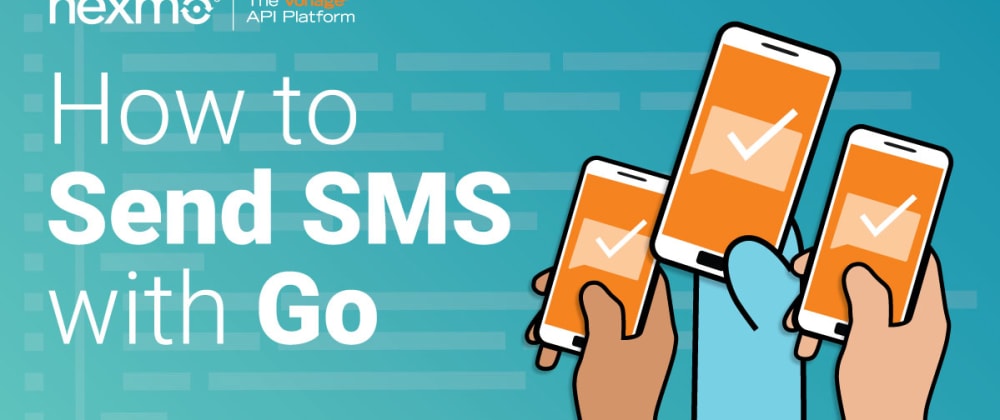In this blog post we’ll show you how to use the nexmo-go client library to send an SMS using Go in around 30 lines of code.
Prerequisites
To follow along with this post you’ll need to have Golang installed on your development machine. Installation instructions can be found on the official Golang website.
Alternatively, if you’re new to Go, or you don’t want to go through the installation process, you can work directly in the Golang Playground instead.
Using the Nexmo API Client for Go
Your SMS and Go journey begins by installing the API client itself. You can do this by running:
go get github.com/nexmo-community/nexmo-go
Next, fire up your editor and create a new file called main.go. Then scaffold the basics of a Go application by typing (or copying) the following code:
package main
import (
"net/http"
"github.com/nexmo-community/nexmo-go"
)
func main() {}
Note: If you save and the files in the import statement disappear, don’t worry, they’ll come back once you use them inside the
main()function.
Now it’s time to put some meat on those bones and instantiate the Nexmo client so you can actually make it do things.
Inside the main() function add the following:
// Auth
auth := nexmo.NewAuthSet()
auth.SetAPISecret("API_KEY", "API_SECRET")
// Init
Nexmoclient := nexmo.NewClient(http.DefaultClient, auth)
There are two things happening here.
First, you create an auth object that combines your API key and secret together using a helper function that will ensure everything is formatted correctly.
Note: Your API key and secret can be found by logging into your Nexmo Dashboard. If you don’t have an account yet, you can sign up here and get a free starter credit to run this code!
Second, you instantiate a new client that will hold all the functionality the nexmo-go library provides. Your auth object is passed into this.
With this in place you can now perform actions on the Nexmo API, such as sending an SMS.
Send SMS Messages With Go
With the Nexmo API client ready to go, your code will now look like this:
package main
import (
"net/http"
"github.com/nexmo-community/nexmo-go"
)
func main() {
// Auth
auth := nexmo.NewAuthSet()
auth.SetAPISecret("API_KEY", "API_SECRET")
// Init
Nexmo client := nexmo.NewClient(http.DefaultClient, auth)
}
In order to send an SMS with Go you first need to create an SendSMSRequest object that contains all of the information the SMS needs to make it to its destination.
As a minimum you should include the number the SMS should be sent to, the number it is sent from and the text to be displayed.
The SendSMSRquest object can be added to main.go below where you instantiated the client and is formatted like this:
smsContent := nexmo.SendSMSRequest{ From: "447700900004", To: "14155550105", Text: "This is a message sent from Go!",}
The To number can be your own number but the From number must be an SMS capable number purchased via your Nexmo Dashboard.
Now the only thing left to do is to tell our app to send the SMS. This is done using the SendSMS function provided by the API client.
Add a new line with the following code:
smsResponse, _, err := client.SMS.SendSMS(smsContent)
Finally, add a quick bit of error checking and response output:
// If there are errors, log them out
if err != nil { log.Fatal(err) }
// All is well, print the message status returned
fmt.Println("Status:", smsResponse.Messages[0].Status)
Now the stage is set to send that SMS! Head to your terminal and from inside the folder you’re working in run:
go run main.go
If everything worked you’ll see Status: 0 returned to the screen just before the familiar sound of your SMS notification rings out signalling your success.
All The Code
For your reference, all the code for sending an SMS with Go comes together like so:
package main
import (
"fmt"
"log"
"net/http"
"github.com/nexmo-community/nexmo-go"
)
func main() {
// Auth
auth := nexmo.NewAuthSet()
auth.SetAPISecret("API_KEY", "API_SECRET")
// Init Nexmo
client := nexmo.NewClient(http.DefaultClient, auth)
// SMS
smsContent := nexmo.SendSMSRequest{ From: "447700900004", To: "14155550105", Text: "This is a message sent from Go!", }
smsResponse, _, err := client.SMS.SendSMS(smsContent)
if err != nil { log.Fatal(err) }
fmt.Println("Status:", smsResponse.Messages[0].Status)}
Where to Go From Here?
The next change you can make to the code above is to make it a little more secure by removing the hardcoded API key, API secret, and the phone numbers.
A good way to do this is to move them to environment variables that are stored in a .env file.
Try implementing this using the godotenv package and quickly shore up your security.
Further Reading
If sending an SMS with Go has go you exicted about what other communication elements you could be adding to your application then take a look at the examples on the nexmo-go GitHub repository.
There you’ll find code for using many other aspects of the Nexmo API such as making phone calls, receiving SMS messages and verifying phone numbers.
As ever, we’re keen to hear from you. If you have questions about using Go with Nexmo consider joining our Nexmo Community on Slack and asking your questions there.
The post How to Send SMS With Go appeared first on Nexmo Developer Blog.







Top comments (2)
Hey Martyn, thanks for the article. I think the varible
Nexmo client := nexmo.NewClient(http.DefaultClient, auth)must beclient := nexmo.NewClient(http.DefaultClient, auth). The space in variable name is confusing.Fixed! Thanks for pointing it out :)